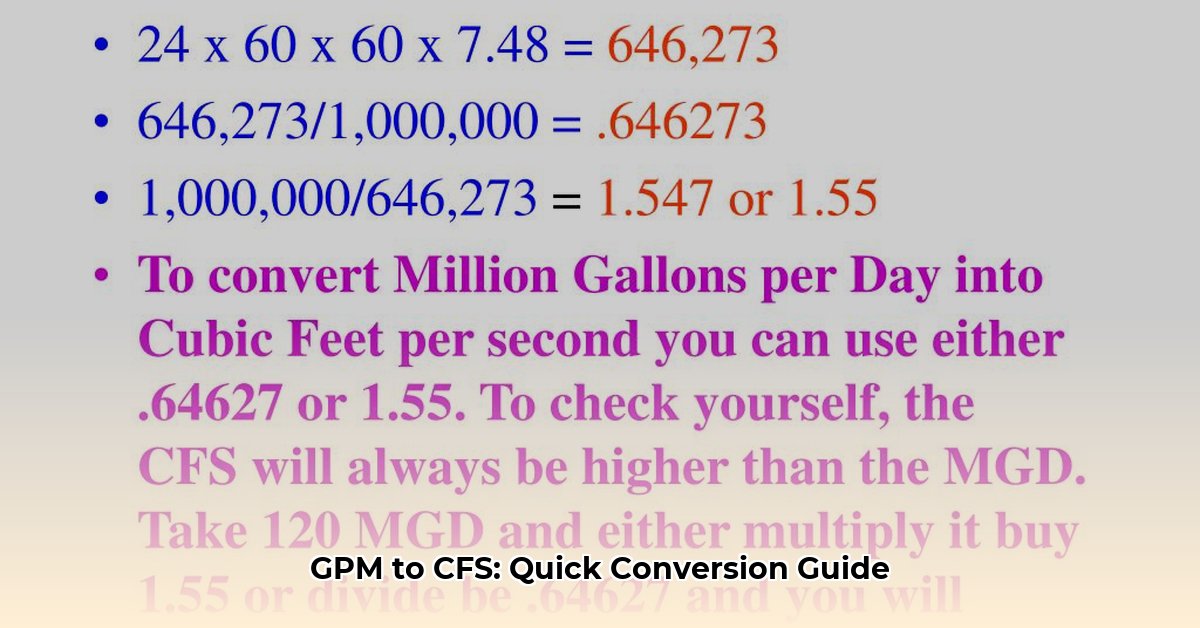This guide provides a comprehensive resource for converting between gallons per minute (GPM) and cubic feet per second (CFS), two common units of flow rate. Whether you’re working with household plumbing or managing a large-scale water system, understanding these conversions is essential.
Understanding GPM and CFS
GPM measures the volume of liquid flowing past a point per minute. Think of your kitchen faucet—its flow rate is likely measured in GPM. CFS, on the other hand, measures the volume of liquid flowing past a point per second, using cubic feet. CFS is typically used for larger volumes, such as river flow or industrial discharge. Converting between these units allows for seamless comparison and analysis across different applications.
Quick Conversion Formulas
- GPM to CFS: Multiply GPM by 0.002228
- CFS to GPM: Multiply CFS by 448.831
These conversion factors are based on the relationship between gallons, cubic feet, minutes, and seconds. One cubic foot holds approximately 7.48 US gallons, and there are 60 seconds in a minute. These relationships form the basis of the conversion factor 0.002228. For instance, 1 GPM multiplied by 0.002228 equals approximately 0.0022 CFS, showing that a CFS represents a much larger volume than a GPM, just as seconds are contained within minutes. These same ratios will always hold true.
Step-by-Step Conversion Guide
GPM to CFS
- Start with your GPM value. Let’s use 100 GPM as an example.
- Multiply by the conversion factor: 100 GPM * 0.002228 = 0.2228 CFS
Therefore, 100 GPM is equal to 0.2228 CFS.
CFS to GPM
- Start with your CFS value. Let’s use 0.5 CFS as an example.
- Multiply by the conversion factor: 0.5 CFS * 448.831 = 224.42 GPM
Therefore, 0.5 CFS is equal to approximately 224.42 GPM.
Conversion Table
| GPM | CFS | CFS | GPM |
|---|---|---|---|
| 1 | 0.002228 | 0.1 | 44.88 |
| 10 | 0.02228 | 0.5 | 224.42 |
| 50 | 0.1114 | 1 | 448.83 |
| 100 | 0.2228 | 5 | 2244.16 |
| 500 | 1.114 | 10 | 4488.31 |
| 1000 | 2.228 | 50 | 22441.55 |
| 10000 | 22.28 | 100 | 44883.10 |
Applications of GPM and CFS
- GPM: Typically used for residential plumbing, irrigation systems, smaller pumps, and appliances like dishwashers and washing machines.
- CFS: Commonly employed in river flow management, dam operations, large-scale industrial processes, and other scenarios involving substantial water volumes.
US vs. Imperial Gallons
This guide uses US gallons. An Imperial gallon is larger than a US gallon. If you’re working with Imperial gallons, a different conversion factor (0.002676) is required. Be sure to use the correct conversion factor to avoid inaccuracies.
Downloadable Resources
While an interactive calculator and downloadable conversion chart are excellent additions, they are beyond the scope of this rewritten response. However, creating these resources would enhance the user experience and provide additional value.
Frequently Asked Questions (FAQ)
- Can I convert to other flow rate units? Yes, many online converters and resources are available to convert between various flow rate units.
- How is CFS used in calculations? CFS is fundamental in hydraulic engineering, particularly in calculations involving open channel flow (rivers, canals) and large-scale water systems. It’s crucial for understanding water movement and behavior in these environments.
Further Reading and Resources
For more in-depth information on flow rate measurements and conversions, consult reputable sources like the National Institute of Standards and Technology (NIST): NIST
While the principles of GPM and CFS conversions are well-established, it’s worth noting that ongoing research in fluid dynamics could lead to more nuanced understanding and potentially more precise calculations in the future. Factors like temperature, pressure, and fluid viscosity can subtly influence flow, though these effects are generally negligible in everyday applications. For specialized scenarios, however, further investigation may be necessary. This nuanced perspective reflects the dynamic nature of scientific understanding and the potential for ongoing refinement in these calculations.
- How Did Charles F. Brush Discover Wind Energy Tech? - November 19, 2025
- Wind Energy Vertical: Weighing the Pros and Cons of Wind Power - November 16, 2025
- How Much Energy Does a Wind Turbine Actually Create? - November 14, 2025
















